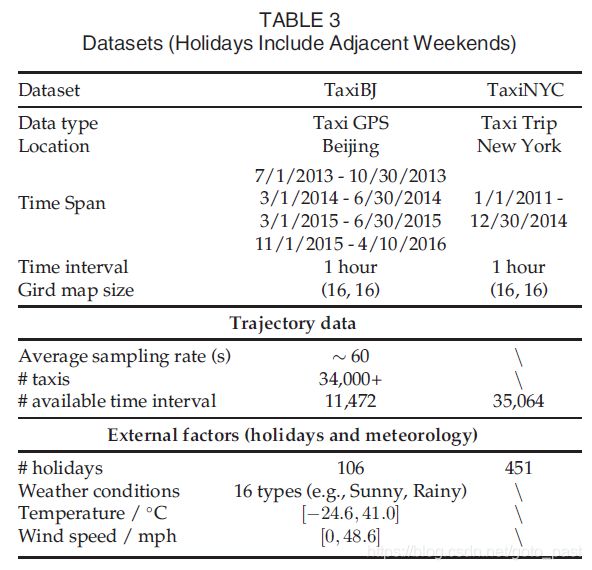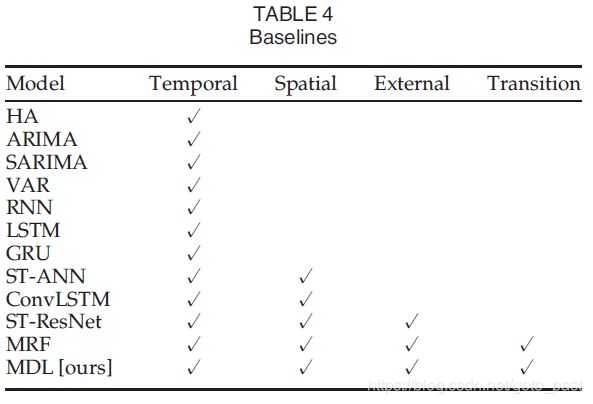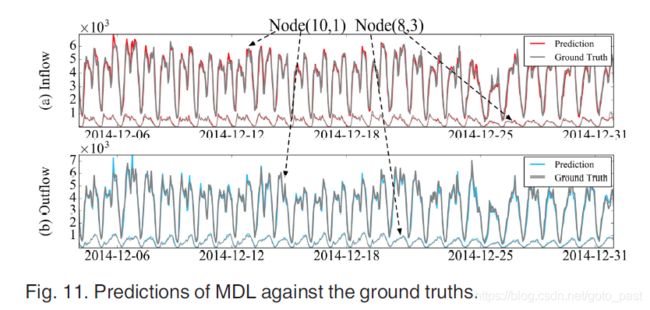基于多任务深度学习的时空网络流量预测 IEEE TKDE 2019
Flow Prediction in Spatio-Temporal Networks Based on Multitask Deep Learning
文章链接: Flow Prediction in Spatio-Temporal Networks Based on Multitask Deep Learning.
Abstract
时空网络中的流量预测(如车辆、人群和自行车的流量)在交通系统中起着重要的作用,它包括一个节点的进出流量和不同节点之间的过度。然而,这是一个非常具有挑战性的问题,它受到多种复杂因素的影响,如不同地点之间的空间相关性、不同时间间隔之间的时间相关性以及外部因素(如事件和天气)。此外,节点处的流(称为node flow)和节点之间的过渡(边缘流edge flow)相互影响。
为了解决这些问题,本文提出了一个多任务深度学习框架,它可以同时预测时空网络中的节点流和边缘流。在全卷积网络的基础上,本文设计了两个复杂的模型,分别用于预测节点流和边缘流。这两个模型通过耦合其中间层的潜在表示连接起来,并一起进行训练。外部因素(external factor)也通过门控融合机制整合到框架中。在边缘流预测模型中,本文采用嵌入组件来处理节点间的稀疏过渡。基于北京和纽约的出租车数据对本文的方法进行了评价。实验结果表明,该方法在ConvLSTM、CNN和马尔可夫随机场等11个基线之外都具有较好的性能。
一、Introduction
学习他的写法

上图说明了SP-network中的node flow和edge flow。
本文所做的工作就是实现以上预测。
挑战(难点):
- Scale and complexity
一个城市具有众多区域(N),区域间的交互存在( N 2 N^2 N2)的可能;同时还要考虑不同时间下的traffic变化,这给传统机器学习模型例如概率图带来了巨大的挑战。 - Model multiple correlations and external factors(模型需要考虑多种相关性和额外因素)
- Dynamics and sparsity
N 2 N^2 N2中交互可能性下,下一时间区域间的transitions具体来看会非常稀疏(相对于 N 2 N^2 N2)。这给预测带来了很大挑战。
为解决以上挑战,本文提出了Multitask Deep-Learning(MDL)来统一和同时地(collectively and simultaneously)预测预测节点和边缘流(flow)。
本文贡献:
- 提出的MDL框架通过deep neural network预测 flow at nodes(entitled NodeNet)和edge flow(entitled EDGENET),这两种深层神经网络通过它们的潜在层连接起来,并一起训练.另外,这两种flow预测也会通过正则化后用在Loss计算。深度神经网络模型可以解决预测问题的大规模和高复杂性,而多任务框架可以相互加强对每种流类型的预测。
- NODENET和EDGENET都由三个stream全卷积网络(3S-FCNs)组成,包括closeness-stream, period-stream和trend-stream,用于捕获3种不同的时间相关特征,FCN全卷积层同时也会捕获近距离和远距离的空间相关性。 模型中添加了门控组件在时空相关性的基础上融入其他因素。为了解决过渡稀疏性问题,本文在EDGENET中设计了一个嵌入组件(embedding compnent),来将稀疏(高维)输入编码为一个潜在的低维表示。
- 在北京和纽约的数据集上进行了实验,验证了MDL相较于其他基线模型的优势。
二、Problem Formulation
首先通过空间map将地理区域划分为不同区块。
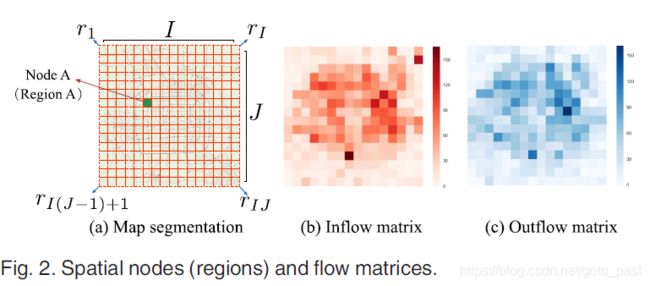
node flow的计算方式:

Transition(edge flow)的计算方式:

将时变图转换为张量:
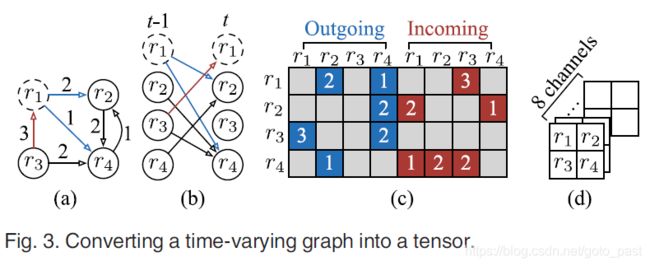
三、Multitask Deep Learning
模型整体框架:

parametric-matrix-based fusion [33] (PM fusion in Fig. 4)用于整合三种不同的FCN结果。
3.1EDGENET
由于transition matrix的稀疏性,本文利用了natural language processing中的embedding方法,将节点 r i j r_{ij} rij的2N-dimension向量映射到k-dimension空间。


另外,为了捕获不同的时间依赖性,本文利用了deep spatio-temporal residual network深度残差网络,可以捕获时间中不同的关键帧(key frames)。

其中p和q为period和trend的时间跨度, l c , l p , l q l_c,l_p,l_q lc,lp,lq分别为三组时间序列的长度。
输出(即下一个时间间隔的预测)与输入具有相同的分辨率。这种任务与众所周知的图像分割问题非常相似,它可以通过全卷积网络(FCN)来处理。本文利用了3-stream FCN 3个流式全卷积网络来分别捕获close period和trend的时间相关性。

FCN中包含了许多卷积层,每层卷积可以捕获邻近的空间相关性,随着卷积层数量的增加,FCN可以捕获越来越来远的空间dependencies。
但这样会大大增加训练难度,因此本文加入了残差连接来帮助训练。
最后文章通过以下操作综合一个节点的close,period,trend时间特征
![]()
3.2NODENET and BRIGGE
nodenet的处理类似edgenet,文章选择了recent、near和distant key frames。通用通过3-stream FCN进行时空信息的的捕获,最后输出为:![]()
之后,文中利用CONCAT Fsusion来综合nodenet和edgenet的输出:

即将通道数相加。
在经过concat fusion后,在最后添加一层卷积,用于将之前的输出恢复到需要预测的形状。


3.3 通过门控机制融合额外因素
外部因素如事故、天气就像一个开关,如果它发生,流动将会发生巨大的变化。
在时间t,本文引入了 ε t = R l e × I × J \varepsilon_t=\mathbb{R}^{l_e\times I\times J} εt=Rle×I×J作为区域下的额外因素,门控机制的计算方式如下:
之后,利用基于门控机制的PRODUCT fusion产生融合额外因素的结果:
![]()

3.4 损失函数
其中P,Q为指示矩阵,用于保留M,X中值大于0(若为0不考虑预测损失)的位置。
之后将二者结合得到:


3.4.1 随机优化过程
四、EXPERIMENTS
模型超参数的影响测试
- 这里感觉纵坐标应该是误差,不知道是不是标错了
两个节点的case study:
五、相关工作
5.1 spatio-temporal prediction
许多研究都试图从时空数据集中找到一些模式和相关性
[17] “Spatiotemporal periodical pattern mining in traffic data,” in Proc. 2nd ACM SIGKDD
[31] “PRED: Periodic region detection for mobility modeling of social media users,”
[32] “Regions, periods, activities: Uncovering Urban dynamics via cross-modal representation learning,”
有一些工作尝试依据历史信息对个人的运动行为进行预测:
[9] “CityMomentum: An online approach for crowd behavior prediction at a citywide level,” in Proc. ACM Int
[24] “Next place predictions based on user mobility traces,”in Proc. IEEE Conf. Comput. Commun. Workshops
[27] “Prediction of human emergency behavior and their mobility following largescale disaster,” in Proc. 20th ACM SIGKDD
一些工作旨在预测公路级的旅行速度和交通量
[1] “Traffic flow prediction for road transportation networks with limited traffic data,” IEEE Trans.
[25] “Predicting traffic volumes and estimating the effects of shocks in massive transportation systems,”
[5] “Road traffic congestion monitoring in social media with hinge-loss Markov random fields,” in Proc. IEEE Int.
[30]“Accurate and interpretable Bayesian MARS for traffic flow prediction,” IEEE Trans.
而城市级的预测包括:
[14] “FCCF: Forecasting citywide crowd flows based on big data,” in Proc. 24th ACM SIGSPATIAL Int.
[21] “Traffic prediction in a bike-sharing system,”in Proc. 23rd SIGSPATIAL
这两项工作都不同于本文的工作,其提出的方法关注的是单个区域而不是城市,它们也没有使用基于网格的方法来分割城市,而网格的方法需要更复杂的方法来首先找到不规则的区域。
5.2 Classical Models for Time Series Prediction
时空网络中的流量预测可以看作是一个时间序列预测问题。现有的timeseries模型,如自回归集成移动平均模型auto-regressive integrated moving average model (ARIMA,[3])、seasonal ARIMA[26]和向量自回归模型the vector autoregressive model[4],可以很好地捕捉时间依赖性,但不能处理空间相关性。
[3] Time Series Analysis: Forecasting and Control
[26] “Comparison of parametric and nonparametric models for traffic flow forecasting,”
[4] “Predictions of freeway traffic speeds and volumes using vector autoregressive models,”
5.3 Neural Networks for Sequence Prediction
神经网络和深度学习[10]在计算视觉[19]、语音识别[11]、自然语言理解[20]等领域都取得了巨大的成功。递归神经网络(RNNs)已成功地用于序列学习任务[28]。长短期记忆(LSTM)[15]或门控复发单元(GRU)[6]的掺入使神经网络能够学习长期的时间依赖性。然而,这些神经网络模型只能捕捉空间或时间依赖性。最近,研究人员将上述网络结合起来,提出了一种同时学习空间和时间依赖关系的卷积LSTM网络[29]。这样的网络不能模拟非常长期的时间依赖性(例如,周期和趋势),随着深度的增加,训练变得更加困难。Zhang等人提出了一种时空残差网络[33],能够捕获时空相关性和外部因素,但它可能不适合处理大型动态图上的转换。
[10] I. Goodfellow, Y. Bengio, and A. Courville, Deep Learning. Cambridge, MA, USA: MIT Press, 2016. [Online]. Available: http:// www.deeplearningbook.org
[19] “ImageNet classification with deep convolutional neural networks,”
[11]“Speech recognition with deep recurrent neural networks,”
[20] “Distributed representations of sentences and documents,” in Proc. 31th Int. Conf. Mach. Learn.,
[28] “Sequence to sequence learning with neural networks,” in Proc. Int. Conf. Neural Inf. Process
[15]“Long short-term memory,” Neural Comput.,
[6]“Learning phrase representations using RNN encoder-decoder for statistical machine translation,” in Proc. Conf. Empirical Methods Natural Language Process.,
[29] “Convolutional LSTM network: A machine learning approach for precipitation nowcasting,” in Proc. Int. Conf. Neural Inf. Process. Syst
[33] “Regions, periods, activities: Uncovering Urban dynamics via cross-modal representation learning,” in Proc. 26th Int. Conf. World Wide Web






